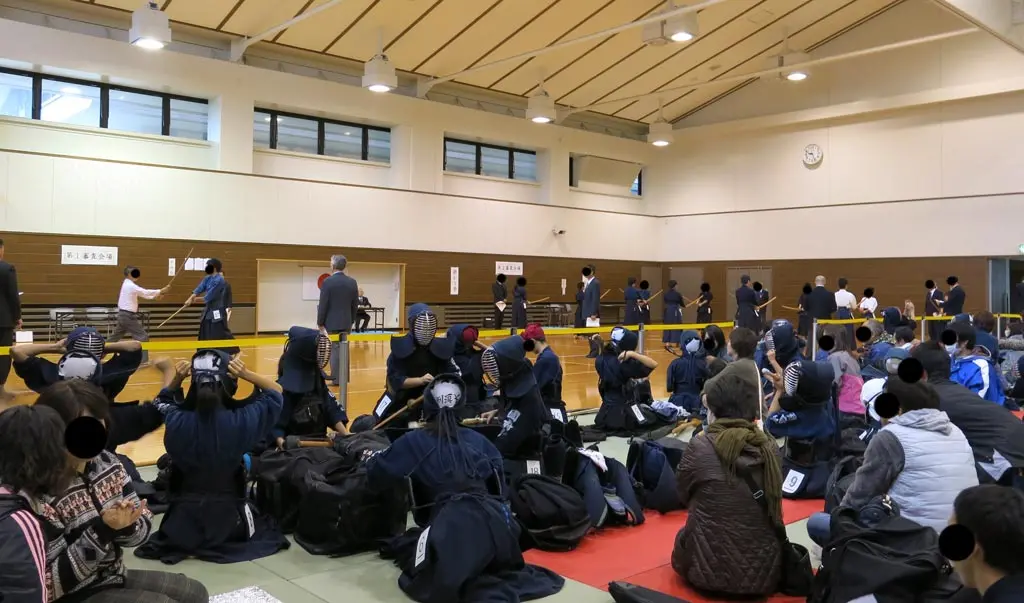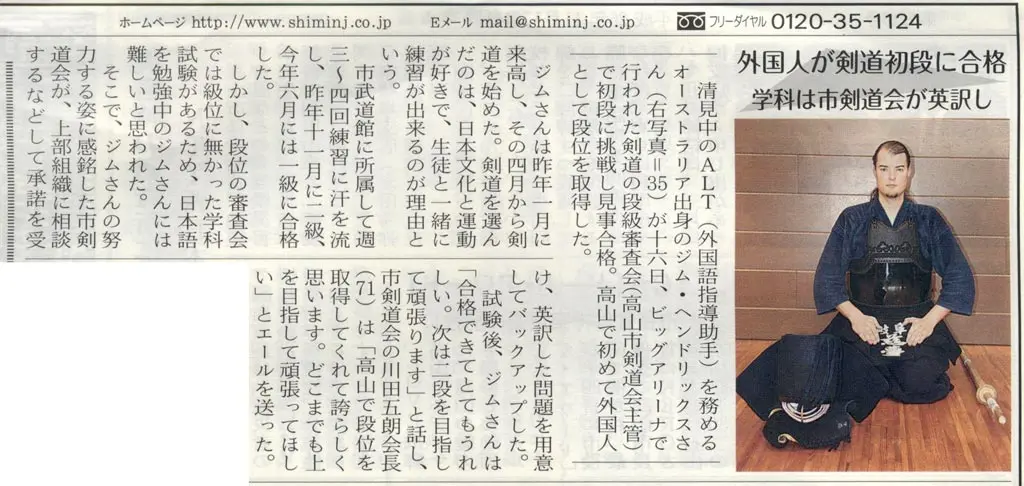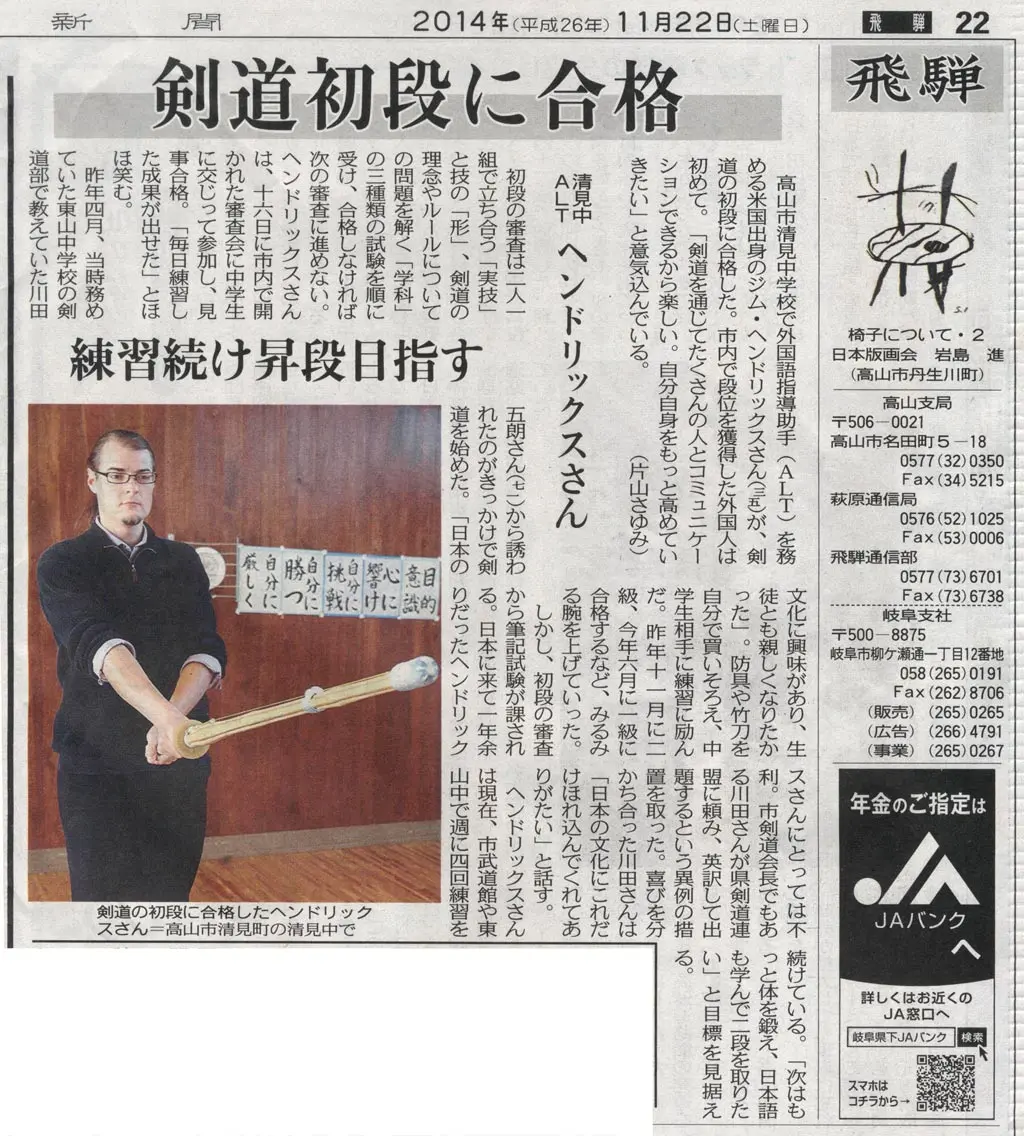It's been about a month, but on Nov 16th, I took and passed my Shodan level Kendo examination. :D
I wrote a little bit about this leading up to the exam on Sept 11th. Shodan 初段, or "first dan", and the first level of dan mastery in Kendo. Dan mastery is somewhat similar to the black belt scale in Karate. So, achieving Shodan is similar to a first level black belt. There are no belts or additional decoration used in Kendo, though.
Prior to dan mastery, there is kyuu mastery, which is reserved for beginners of Kendo, usually elementary students, and beginning junior high students.
The test was held at Big Arena on Sunday Nov 16th. The doors to Big Arena opened at 8am, and there were plenty of students waiting by the doors before then. Additionally, there were basketball and table tennis tournaments held that day, too. The Kendo test was held in the martial arts hall within the complex.
As the doors opened, everyone filled into the building. I went upstairs and into the testing area. Several of the beginner students I practice with were there taking the Kyuu tests for the first time. One of my former students was there taking the "second dan" test, ni-dan 二段. I had been practicing with him for the past month in preparation. :)
Everyone registered for their respective tests, and paid their fees. The Shodan test was almost 10000円 ($100).
The Kyuu-level tests began at 9am. They first began with correct execution of the Kendo waza techniques. These are a series of moves performed with another test taker. One acts as the attacker. The other as the defender. Then when complete they switch roles. These are performed with a bokutou 木刀 (wooden sword), and without any protective gear. The moves are performed in a deliberate and methodical way to correctly show one's understanding of how the move is to be correctly executed.

Secondly, the test takers are evaluated on moves performed in real-time. These moves are performed with all the gear worn by the test taker, and with a shinai 竹刀 (bamboo sword). Same as the first test, test takers perform these moves on each other. One is the attacker. The other is the defender. Then they switch. Additionally, for "first kyuu", or Ikkyuu 一級, the test ends with both test takers performing as many moves as they can against each other in a "practice" match. The lower levels don't require this.
As the different kyuu-level tests complete, the results are posted on the wall, the taker's kendo licenses are stamped and certificates are handed out.
Once all the Kyuu tests were complete, then the Dan tests finally began. I think our tests began 10:30. There are 3 tests, and each is immediate elimination. Meaning: if you fail a test, you do not continue. I was most worried about the first test.
The first test is a practice shiai 試合, or match, but it's performed much differently than in a tournament. In this match, when you meet your opponent, you carefully study their posture, their movements, and their feelings. When you understand your opponent, then you can interpret intentions, and correctly strike and respond to their movements.
My biggest problem with doing this part of the test is my bulky slow-ass giant body. These junior high kids are way too fast for me. For some students, I can see their attacks coming, but I can't parry and counter fast enough to make a valid strike. Other times, I can't even see their attacks coming because they whip around their shinai so fast.
This test isn't about winning or losing, though. Reading your opponent is certainly key. But more important is that you follow through with your movements to completion. At least, that's how I understand it. I think there are other factors at play, too.
For this test, examinees perform twice against two other examinees, and each match is one minute. That's it. As usual, I was in the last group. I took my turn, and performed the test as I understood it. I was certainly nervous, but I had been practicing so much over the past 2 months, and regularly practicing with students of similar level that it really didn't bother me as much as it did during the previous test. I knew what to do.
So, I passed the first part of the test without a problem. I was slow a couple of times, but I guess I was sufficient where it mattered.
After more than an hour lunch break, we continued the test with the reminder of the test takers. All the kyuu-level examinees were already gone at this point, so the crowd of parents was pretty sparse.
Part 2 is correctly performing dan-level waza, which are higher-level kendo techniques performed with a bokutou 木刀. I had been practicing these so much over the previous 3-4 months that they were completely internalized. All the kendo instructors kept putting such an importance on them that I don't think I could ever forgot them. During the test, though, we only needed to perform one side of the waza. We were random chosen to either be attacker or defender, and that was it. All examinees passed.
Part 3 of the test was the written exam. This is what I wrote about before: Sept 11th. There are 4 questions total on the test chosen from a pool of 6. Each examinee basically needed to memorize the answer, and write it down on the test. You didn't need to write it in your own words. And didn't need to write anything dealing with comprehension. Only memorization. (In my opinion, that doesn't really teach anything, but whatever.)
My written test was completely in English because I'm terrible at Japanese. The English answers for the test were somewhat based on my translation of the booklet, too, so memorizing the answers was pretty easy (since they were written in my voice). I was able to completely memorize the 6 questions within two days on the test. Apparently, when grading my test, the proctor had commented that I had written everything 100% perfect.
So, I passed. :) So too did everyone else that made it to this point.
I am one of perhaps ten or twenty foreigners to ever take and pass the Shodan exam in Gifu-ken.
I was rather nervous about whether I could pass the test, but a lot of that nervousness turned into confidence as the test drew closer. I had been training every day leading up to the test, and was doing everything nearly perfect during practice. My waza was totally perfect a few weeks prior to the test. And I knew I could memorize the written part. This was my third time taking a kendo exam, too, so I knew what to expect, and how to deal with things. I didn't want to be too confident and have that turn to arrogance... but I knew I could pass.
Some of the student's parents were pretty confident I could pass as well. They called the newspaper prior to the test so they could interview me and write an article about me. The reporter asked me rather standard questions. "How do you feel?" "How long have you done Kendo?" "Why do you do Kendo?" etc. They asked my Kendo instructor questions as well.
It appeared in the Takayama newspaper the next day:
This brought me plenty of attention.
My student's parents read the newspaper, and noticed me. The next day at school, all the students made comments about it, and congratulated me. ジム先生、初段におめでとう! Some parents made their kids memorize their congratulations in English, and recite it to me. Several teachers made a big deal out of it, too, making the whole class congratulate me before we started. Plenty of students knew that I practiced and performed Kendo after school, but now everyone knew.
On Friday, a reporter from the Hida section of the Gifu newspaper wanted to write an article of their own. They came to school, and interviewed me for about an hour. She asked the same questions, but with more depth.
Again, the next day, it appeared in the paper:
Between both these articles, I don't actually know the extent of what they wrote, since I'm terrible at Japanese. It's also difficult for me to fully articulate myself when I can't do it in Japanese, and the person doesn't completely understand English. As such, I don't think my responses were really all that interesting. Nor can I really tell if they printed some shit about me. (I did notice in the first article that I'm from Australia.)
This newspaper reaches A LOT more people than the Takayama paper. Plus, it was the top story in this section of the newspaper, and it took up about a quarter of the page.
Now, everyone in my daily life knew that I did Kendo, and couldn't wait to congratulate me. Teachers in other schools that I hadn't met, congratulated me. The employees working at the convenience stores, grocery stores, gas station, and dry cleaning places I regularly visit, all recognized me in the paper and congratulated me the next time I went there. Even the delivery man made a comment after dropping off a package. いつもおめでとう. 剣道をがんばってましょう.
It wasn't that I hated the attention. I mean, I already stand out quite a bit as a foreigner, which gives me attention on its own. This is now yet another way of people paying attention to me. Too much attention. It was all positive attention, though, so I'm thankful for that. :)
Kendo continues to be amazing for me in Takayama, so I will absolutely continue to improve myself, and climb the rankings ladder. After shodan 初段, the next level of mastery is nidan 二段, or "second dan." The rules of ranking prohibit anyone from taking the nidan exam until one year after achieving shodan. So, I won't be able to get nidan until November 2015.
As mentioned earlier, maybe 10 or 20 foreigners have gotten shodan in Gifu in the past. Maybe 1 or 2 have gotten nidan. None have ever gotten sandan 三段 (third dan). I don't think that's necessarily because of a skill-gap, or difficulty gap (though, I could be wrong.) Nidan seems almost identical to Shodan, with the addition of more waza, and some different questions on the test.
I think the biggest gap is time. Most ALTs only stay in Japan for 3 years at the most. It's not that usual for someone to stay 4 or 5 years (which is the absolute max). Between shodan and nidan, you must wait a year. Between nidan and sandan, you must wait 2 years. At this point, if I pass my nidan test next year, and stay for a 5th year, my sandan test would be after my contract is finished in Takayama. I'm not sure where I'll be in November 2017, but it won't be Takayama.
I definitely plan on getting nidan 二段 next year. From there, I plan on continuing Kendo all the way up until I leave Takayama. Hopefully where I am after, I will have the means to continue, then return to Takayama for the sandan test. Who knows, though. A lot can happen in the next 2 1/2 years.

